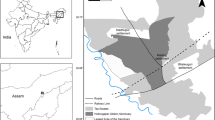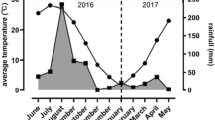Abstract
Understanding fig consumption patterns is important because figs are regarded as a keystone resource for many frugivorous species in the tropics. While much work on fig consumption has been conducted in tropical regions, temperate forests are particularly interesting for study owing to pronounced seasonal variations in temperature and community-level fruiting phenology. We studied frugivore consumption of Ficus superba (Miq.) Miq. var. japonica Miq syconia in a warm-temperate forest in Yakushima, southern Japan. We conducted 141 4-h focal observations of fruiting F. superba trees over 12 months. We aimed to assess the relative quantitative contribution of each species of frugivore to F. superba consumption over a year as well as factors affecting seasonal variation in consumption. Japanese macaques were by far the most important F. superba syconia consumer (87.6 %), followed by brown-eared bulbuls (5.0 %), and varied tits (4.2 %). Japanese macaques increased their F. superba consumption when the temperature was high and fruit availability (F. superba and other species) was low. Macaques seemed to avoid searching for rare F. superba trees during winter and used F. superba syconia as a fallback food during fruit scarcity. Birds showed the opposite pattern: they increased F. superba syconia consumption when the temperature was low and fruit availability was high. This was probably because birds eat insects as their main food in the summer and switch to fruit as autumn turns to winter.



Similar content being viewed by others
References
Agetsuma N (1995) Dietary selection by Yakushima macaques (Macaca fuscata yakui): the influence of food availability and temperature. Int J Primatol 16:611–627
Balcomb SR, Chapman CA (2003) Bridging the gap: influence of seed deposition on seedling recruitment in a primate-tree interaction. Ecol Monogr 73:625–642
Coates-Estrada R, Estrada A (1986) Fruiting and frugivores at a strangler fig in the tropical rain forest of Los Tuxtlas, Mexico. J Trop Ecol 2:349–358
Dunning BD (2016) Body masses of birds of the world. https://ag.purdue.edu/fnr/Documents/BodyMassesBirds.pdf. Accessed May 8, 2016
Eguchi K (1979) Food and food consumption of nestling tits, Parus major major and Parus varius varius, in the evergreen broad-leaved forests in northern Kyushu [Japan]. J Yamashina Inst Ornithol 11:1–19
Eguchi T (1984) Climate of Yaku-shima Island, especially regionality of precipitation distribution. In: EA Nature Conservation Bureau, Japan (ed) Conservation reports of the Yaku-shima wilderness area, Kyushu, Japan. Environment Agency, Tokyo, pp 3–26
Fuentes M (1992) Latitudinal and elevational variation in fruiting phenology among western European bird-dispersed plants. Ecography 15:177–183
Fukui AW (1995) The role of the brown-eared bulbul Hypsypetes amaurotis as a seed dispersal agent. Res Popul Ecol 37:211–218. doi:10.1007/bf02515822
Gautier-Hion A, Michaloud G (1989) Are figs always keystone resources for tropical frugivorous vertebrates? a test in Gabon. Ecology 70:1826–1833
Gautier-Hion A, Duplantier JM, Quris R, Feer F, Sourd C, Decoux JP, Dubost G, Emmons L, Erard C, Hecketsweiler P, Moungazi A, Roussilhon C, Thiollay JM (1985) Fruit characters as a basis of fruit choice and seed dispersal in a tropical forest vertebrate community. Oecologia 65:324–337
Goodman SM, Ganzhorn JU, Wilme L (1997) Observations at a Ficus tree in Malagasy humid forest. Biotropica 29:480–488. doi:10.1111/j.1744-7429.1997.tb00042.x
Hanya G (2004a) Diet of a Japanese macaque troop in the coniferous forest of Yakushima. Int J Primatol 25:55–71
Hanya G (2004b) Seasonal variations in the activity budget of Japanese macaques in the coniferous forest of Yakushima: effects of food and temperature. Am J Primatol 63:165–177
Hanya G (2005) Comparisons of dispersal success between the species fruiting prior to and those at the peak of migrant frugivore abundance. Plant Ecol 181:167–177
Hanya G, Aiba S (2010) Fruit fall in tropical and temperate forests: implications for frugivore diversity. Ecol Res 25:1081–1090. doi:10.1007/s11284-010-0733-z
Hanya G, Yoshihiro S, Zamma K, Matsubara H, Ohtake M, Kubo R, Noma N, Agetsuma N, Takahata Y (2004) Environmental determinants of the altitudinal variations in relative group densities of Japanese macaques on Yakushima. Ecol Res 19:485–493
Hanya G, Kiyono M, Yamada A, Suzuki K, Furukawa M, Yoshida Y, Chijiiwa A (2006) Not only annual food abundance but also fallback food quality determines the Japanese macaque density: evidence from seasonal variations in home range size. Primates 47:275–278
Hanya G, Stevenson P, van Noordwijk M, Wong ST, Kanamori T, Kuze N, Aiba S, Chapman CA, van Schaik C (2011) Seasonality in fruit availability affects frugivorous primate biomass and species richness. Ecography 34:1009–1017. doi:10.1111/j.1600-0587.2010.06775.x
Hanya G, Tsuji Y, Grueter CC (2013) Fruiting and flushing phenology in Asian tropical and temperate forests: implications for primate ecology. Primates 54:101–110. doi:10.1007/s10329-012-0341-3
Hemingway C, Bynum N (2005) The influence of seasonality on primate diet and ranging. In: Brockman DK, van Schaik CP (eds) Seasonality in primates: studies of living and extinct human and non-human primates. Cambridge University Press, Cambridge, pp 57–104
Herrera CM (1984) A study of avian frugivores, bird-dispersed plants, and their interaction in Mediterranean scrublands. Ecol Monogr 54:1–23
Higuchi H (1976) Home range and pair duration in the varied tit Parus varius. Tori 25:69–80
Higuchi H, Morioka H, Yamagishi S (1997) The encyclopaedia of animals in Japan, vol 4, Birds 2. Heibonsya, Tokyo
Hill DA (1997) Seasonal variation in the feeding behavior and diet of Japanese macaques (Macaca fuscata yakui) in lowland forest of Yakushima. Am J Primatol 43:305–322
Howe HF (1980) Monkey dispersal and waste of a neotropical fruit. Ecology 61:944–959
Janzen DH (1979) How to be a fig. Annu Rev Ecol Syst 10:13–51
Jordano P (1983) Fig-seed predation and dispersal by birds. Biotropica 15:38–41
Kattan GH, Valenzuela LA (2013) Phenology, abundance and consumers of figs (Ficus spp.) in a tropical cloud forest: evaluation of a potential keystone resource. J Trop Ecol 29:401–407. doi:10.1017/s0266467413000461
Kitamura S, Yumoto T, Poonswad P, Chuailua P, Plongmai K, Maruhashi T, Noma N (2002) Interactions between fleshy fruits and frugivores in a tropical seasonal forest in Thailand. Oecologia 133:559–572
Koike S, Masaki T, Nemoto Y, Kozakai C, Yamazaki K, Kasai S, Nakajima A, Kaji K (2011) Estimate of the seed shadow created by the Asiatic black bear Ursus thibetanus and its characteristics as a seed disperser in Japanese cool-temperate forest. Oikos 120:280–290. doi:10.1111/j.1600-0706.2010.18626.x
Lambert FR (1989) Pigeons as seed predators and dispersers of figs in a Malaysian lowland forest. Ibis 131:521–527. doi:10.1111/j.1474-919X.1989.tb04788.x
Leighton M, Leighton DR (1983) Vertebrate responses to fruiting seasonality within a Bornean rain forest. In: Sutton SL, Whitmore TC, Chadwick AC (eds) Tropical rain forest: ecology and management, vol 2. Blackwell Scientific Publications, Palo Alto, pp 181–196
Lomáscolo SB, Speranza P, Kimball RT (2008) Correlated evolution of fig size and color supports the dispersal syndromes hypothesis. Oecologia 156:783–796. doi:10.1007/s00442-008-1023-0
Maruhashi T (1980) Feeding behavior and diet of the Japanese monkey (Macaca fuscata yakui) on Yakushima Island, Japan. Primates 21:141–160. doi:10.1007/bf02374030
Maruhashi T (1982) An ecological study of troop fissions of Japanese monkeys (Macaca fuscata yakui) on Yakushima Island, Japan. Primates 23:317–337. doi:10.1007/bf02381317
Mori A (1979) Analysis of population changes by measurement of body weight in the Koshima troop of Japanese monkeys. Primates 20:371–398. doi:10.1007/bf02373390
Nakagawa N, Iwamoto T, Yokota N, Soumah AG (1996) Inter-regional and inter-seasonal variations of food quality in Japanese macaques: constraints of digestive volume and feeding time. In: Fa JE, Lindburg DG (eds) Evolution and ecology of macaque societies. Cambridge Univ Press, New York, pp 207–234
Nakashima Y, Lagan P, Kitayama K (2008) A study of fruit-frugivore interactions in two species of durian (Durio, Bombacaceae) in Sabah, Malaysia. Biotropica 40:255–258. doi:10.1111/j.1744-7429.2007.00335.x
Neter J, Kutner M, Nachtsheim C, Wasserman W (2004) Applied linear regression models, 5th edn. McGraw-Hill/Irwin, New York
Noma N, Yumoto T (1997) Fruiting phenology of animal-dispersed plants in response to winter migration of frugivores in a warm temperate forest on Yakushima Island, Japan. Ecol Res 12:119–129
Otani T (2001) Measuring fig foraging frequency of the Yakushima macaque by using automatic cameras. Ecol Res 16:49–54
Schupp EW, Jordano P, Gomez JM (2010) Seed dispersal effectiveness revisited: a conceptual review. New Phytol 188:333–353. doi:10.1111/j.1469-8137.2010.03402.x
Sewall BJ, Freestone AL, Hawes JE, Andriamanarina E (2013) Size-energy relationships in ecological communities. PLoS One 8:10. doi:10.1371/journal.pone.0068657
Shanahan M, Compton SG (2001) Vertical stratification of figs and fig-eaters in a Bornean lowland rain forest: how is the canopy different? Plant Ecol 153:121–132. doi:10.1023/a:1017537707010
Shanahan M, So S, Compton SG, Corlett R (2001) Fig-eating by vertebrate frugivores: a global review. Biol Rev 76:529–572
Sreekar R, Nghiem TPL, Harrison RD (2010) Vertebrate assemblage at a fruiting fig (Ficus caulocarpa) in Maliau basin, Malaysia. Trop Conserv Sci 3:218–227
Stevenson PR (2001) The relationship between fruit production and primate abundance in Neotropical communities. Biol J Linnean Soc 72:161–178
Tello JG (2003) Frugivores at a fruiting Ficus in south-eastern Peru. J Trop Ecol 19:717–721
Terakawa M, Matsui K, Hamada T, Noma N, Yumoto T (2008) Reduced seed dispersal effectiveness in the large-seeded tree Myrica rubra in the absence of the Japanese macaque on Tanegashima Island, Japan (in Japanese). Jpn J Cons Ecol 13:161–167
Terakawa M, Isagi Y, Matsui K, Yumoto T (2009) Microsatellite analysis of the maternal origin of Myrica rubra seeds in the feces of Japanese macaques. Ecol Res 24:663–670. doi:10.1007/s11284-008-0537-6
Thompson JN, Willson MF (1979) Evolution of temperate fruit-bird interactions: phenological strategies. Evolution 33:973–982
Tsuji Y, Tatewaki T, Kanda E (2011) Endozoochorous seed dispersal by sympatric mustelids, Martes melampus and Mustela itatsi, in western Tokyo, central Japan. Mamm Biol 76:628–633. doi:10.1016/j.mambio.2011.01.002
Tsuji Y, Hanya G, Grueter CC (2013) Feeding strategies of primates in temperate and alpine forests: comparison of Asian macaques and colobines. Primates 54:201–215. doi:10.1007/s10329-013-0359-1
Wrangham RW, Conklin NL, Etot G, Obua J, Hunt KD, Hauser MD, Clark AP (1993) The value of figs to chimpanzees. Int J Primatol 14:243–256
Yoshihiro S, Ohtake M, Matsubara H, Zamma K, Hanya G, Tanimura Y, Kubota H, Kubo R, Arakane T, Hirata T, Furukawa M, Sato A, Takahata Y (1999) Vertical distribution of wild Yakushima macaques (Macaca fuscata yakui) in the western area of Yakushima Island, Japan: preliminary report. Primates 40:409–415
Acknowledgments
We would like to thank our friends and colleagues in Yakushima for their hospitality and help during the fieldwork. Drs. Otani T. and Sawada A. offered us location data for the trees monitored in the phenology census. Dr. Aiba S. gave us temperature data. Dr. Tsujino R, Prof. Yumoto T, anonymous reviewers and editors of this journal, and the members of the Department of Ecology and Social Behavior, Primate Research Institute, Kyoto University, offered us helpful comments. Yakushima Forest Ecosystem Conservation Center and Yakushima National Park permitted our research. This study was financially and logistically supported by the Cooperation Research Program of Wildlife Research Center, Kyoto University and Grant-in-Aid for Challenging Exploratory Research to GH (#23657018, #15K14604).
Author information
Authors and Affiliations
Corresponding author
Electronic supplementary material
Below is the link to the electronic supplementary material.
About this article
Cite this article
Hamada, A., Hanya, G. Frugivore assemblage of Ficus superba in a warm-temperate forest in Yakushima, Japan. Ecol Res 31, 903–911 (2016). https://doi.org/10.1007/s11284-016-1398-z
Received:
Accepted:
Published:
Issue Date:
DOI: https://doi.org/10.1007/s11284-016-1398-z




